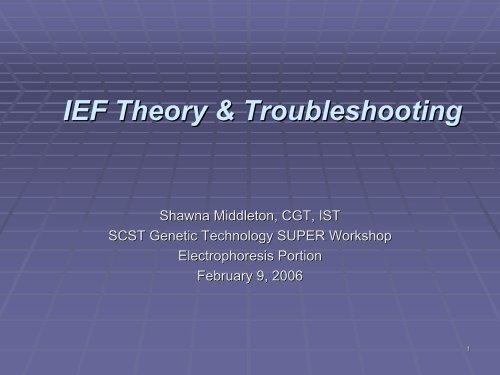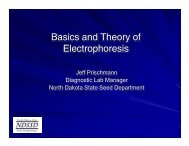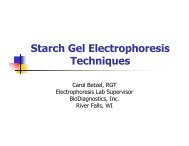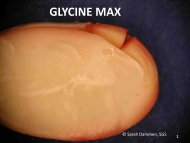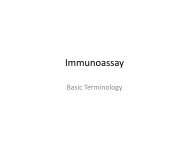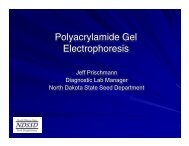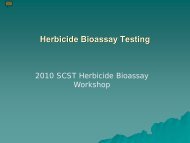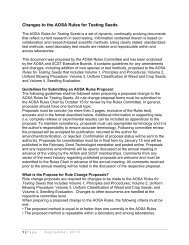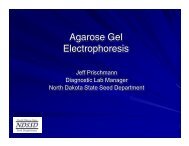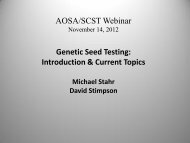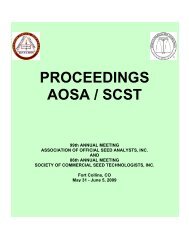IEF Theory & Technique
IEF Theory & Technique
IEF Theory & Technique
Create successful ePaper yourself
Turn your PDF publications into a flip-book with our unique Google optimized e-Paper software.
<strong>IEF</strong> <strong>Theory</strong> & Troubleshooting<br />
Shawna Middleton, CGT, IST<br />
SCST Genetic Technology SUPER Workshop<br />
Electrophoresis Portion<br />
February 9, 2006<br />
1
Overview<br />
• What is <strong>IEF</strong>?<br />
• What is pH?<br />
• What are Proteins?<br />
• Protein Classifications<br />
• Migration of Proteins<br />
• Putting it all together<br />
• Troubleshooting<br />
2
What is <strong>IEF</strong>?<br />
• Isoelectric focusing (<strong>IEF</strong>) is an<br />
electrophoresis molecular diagnostic tool<br />
that separates protein in a gel matrix that<br />
has a pH gradient<br />
• It is limited to molecules which can be<br />
positively or negatively charged (proteins,<br />
enzymes, peptides)<br />
3
What is pH?<br />
• pH is the<br />
universally<br />
accepted scale to<br />
measure how<br />
acidic, basic, or<br />
neutral a solution<br />
is<br />
• Analogy –<br />
Temperature (Hot<br />
& Cold)<br />
4
pH cont.<br />
• Water H 2 O H + OH<br />
• 2 Hydrogen Atoms – positively charged<br />
• 1 Oxygen Atom – negatively charged<br />
5
What are Proteins?<br />
• Most abundant biological macromolecule occurring in all<br />
cells and all parts of cells<br />
Extraction Method<br />
• Molecular instruments through which genetic information<br />
is expressed<br />
• 2 Key Properties of Proteins in Relation to <strong>IEF</strong><br />
• Amphoteric<br />
• Isoelectric<br />
6
Amphoteric Property<br />
• Proteins can<br />
exist positively<br />
or negatively<br />
charged<br />
• This allows<br />
them to be<br />
separated<br />
according to pH<br />
7
Isoelectric Point (pI) Property<br />
• Net charge v.s. the pH results in a continuous curve<br />
which intersects at the isoelectric point<br />
• Once proteins have reached their isoelectric point, the<br />
protein has reached a net zero charge<br />
8
Classification of Seed Proteins<br />
Used to determine electrophoresis application<br />
Name<br />
Albumins<br />
Globulins<br />
Prolamines<br />
Glutelins<br />
Osborne Classification System<br />
Solubility<br />
Soluble in water or dilute salt<br />
solutions; coagulated by heat<br />
Insoluble in pure water and<br />
high salt solutions; Soluble in<br />
dilute salt solutions<br />
Soluble in aqueous alcohol<br />
Insoluble in neutral salt or<br />
alcohol; Soluble in dilute<br />
alkali, acids, detergents,<br />
disassociating (urea) or<br />
reducing (β-mercaptoethanol)(<br />
Examples<br />
Enzymes<br />
Membrane<br />
bound bodies<br />
and seed<br />
storage proteins<br />
True storage<br />
proteins<br />
Structural<br />
proteins<br />
Examples of Ext<br />
Solution for <strong>IEF</strong><br />
Phosphate (PES)<br />
Water<br />
TMU/EG<br />
MTG/EG<br />
Ethylene Glycol<br />
2-choloroethanol<br />
This protein<br />
classification is not<br />
currently tested for<br />
in <strong>IEF</strong><br />
9
Migration of Proteins<br />
(A)<br />
(B)<br />
A pH gradient is established in a gel before loading the sample due to carrier<br />
ampholytes (small, soluble, amphoteric molecules with a high buffering capacity near<br />
their pI), Carrier ampholytes with lowest pI or most negative charge will move towards<br />
the anode, highest pI or most positive charge will move towards the cathode, others<br />
will align between the extremes and thus a pH gradient is created;<br />
The sample is loaded and voltage is applied; the proteins will migrate to their<br />
Isoelectric pH, the location at which they have no net charge<br />
10
Migration of Proteins cont.<br />
• Protein with the lowest known<br />
pI is the acidic glycoprotein of<br />
chimpanzees (pI=1.8)<br />
• Protein with the highest known<br />
pI is lysozyme from the human<br />
placenta (pI=11.7)<br />
• When the mixture of proteins is<br />
applied to the gel, the<br />
positively charged proteins<br />
migrate towards the cathode,<br />
the negatively charged<br />
towards the anode until they<br />
reach the pH value where they<br />
are isoelectric (net charge is<br />
zero)<br />
Cathode<br />
Anode<br />
11
Putting it all Together<br />
• Isoelectric focusing (<strong>IEF</strong>) is an electrophoresis molecular diagnostic<br />
tool that separates protein in a pH gradient<br />
• Each lane below is a single seed, each seed with multiple proteins<br />
12
Troubleshooting<br />
Symptom<br />
Gel peels away from<br />
support film<br />
Cause<br />
Wrong support film was<br />
used<br />
Wrong side of support<br />
film was used<br />
Support film was<br />
incorrectly stored or too<br />
old<br />
Remedy<br />
Use correct film<br />
Gel should be cast on<br />
hydrophilic side of the<br />
support film<br />
Store film in cool, dry<br />
and dark place; check<br />
expiration date<br />
13
Troubleshooting cont.<br />
Symptom<br />
No current<br />
Too low current or no<br />
current<br />
Current rises during the<br />
<strong>IEF</strong> run<br />
Cause<br />
Safety turn off “ground<br />
leakage” because of<br />
massive short circuit<br />
Poor or no contact<br />
between the electrodes<br />
and electrode strips<br />
The connection cable is<br />
not plugged in<br />
Electrode strips,<br />
electrodes mixed up;<br />
Electrode solution<br />
incorrect<br />
Remedy<br />
Turn off power supply,<br />
check the cables<br />
Make sure the electrode<br />
strips are correctly<br />
placed<br />
Check the plug; press<br />
the plug in more securely<br />
into the power supply<br />
Acid solution at the<br />
anode, basic solution at<br />
the cathode<br />
14
Troubleshooting cont.<br />
Symptom<br />
General condensation<br />
Cause<br />
The power setting is too<br />
high<br />
Insufficient cooling<br />
Remedy<br />
Check the power supply<br />
settings<br />
Check the temperature,<br />
check the flow of the<br />
cooling tube (bent tube)<br />
Condensation at the<br />
sample application site<br />
Excessive salt<br />
concentration in the<br />
sample which is causing<br />
local overheating<br />
Desalt the sample<br />
15
Troubleshooting cont.<br />
Symptom<br />
Condensation around<br />
the electrode strips<br />
Local condensation<br />
Cause<br />
Electrode strips reversed<br />
or contaminated<br />
Localized hot spots due<br />
to bubbles between the<br />
gel and the cooling plate<br />
Remedy<br />
Acid solution at the<br />
anode, basic solution a<br />
the cathode<br />
Remove the air bubbles,<br />
avoid them from the<br />
beginning if possible<br />
Sparking of the gel<br />
Some causes of<br />
condensation or dried<br />
out gel<br />
Same remedy for<br />
condensation, store gels<br />
properly<br />
16
Troubleshooting cont.<br />
Symptom<br />
Sparking along the edge<br />
of the support film<br />
Missing bands<br />
Flooding on the surface<br />
of the gel<br />
Cause<br />
Electrode strips hang<br />
over the edge of the gel<br />
Concentration of the<br />
extraction too low;<br />
detection method not<br />
sensitive enough<br />
The gel surface was not<br />
blotted<br />
Remedy<br />
Cut the electrode strips<br />
to the size of the gel<br />
Apply more sample to<br />
the template or<br />
concentrate the sample<br />
Use another detection<br />
method<br />
Always blot the surface<br />
of the gel<br />
17
Troubleshooting cont.<br />
Symptom<br />
Distorted bands at the<br />
edges of the gel<br />
Cause<br />
The wrong electrode<br />
solution was used<br />
The electrode strips are too<br />
wet<br />
Fluid has ran out of the<br />
edge of the electrodes and<br />
along the edge of the gel<br />
forming an L-shaped L<br />
electrode; The samples<br />
were applied too close to<br />
the edge of the gel<br />
Remedy<br />
In general it is<br />
recommended to use 0.25<br />
mol/L acetic acid at the<br />
anode wick and 0.25 mol/L<br />
sodium hydroxide at the<br />
cathode<br />
Remove the excess liquid;<br />
blot the electrode wicks so<br />
that they almost appear<br />
almost dry<br />
Blot the gel or electrode<br />
strips often when water<br />
oozes out; apply the sample<br />
about 1 cm from the edge<br />
18
QUESTIONS?<br />
19


